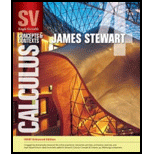
A tangent line is drawn to the hyperbola xy = c at a point P.
(a) Show that the midpoint of the line segment cut from this tangent line by the coordinate axes is P.
(b) Show that the triangle formed by the tangent line and the coordinate axes always has the same area, no matter where P is located on the hyperbola.
(a)
To show: The midpoint of the line segment cut from the tangent line by coordinate axes P.
Explanation of Solution
Given:
The equation of the hyperbola is
Derivative rules:
(1) Power Rule:
(2) Constant multiple rule:
Formula Used:
The equation of the tangent line at
where, m is the slope of the tangent line at
Proof:
Obtain the slope of the tangent line to the hyperbola at P.
The derivative of hyperbola y is
Apply the constant multiple rule (2) and the power rule (1),
Thus, the derivative of y is
Therefore, the slope of the tangent to the hyperbola is
Since the hyperbola is
Substitute
Thus, the equation of tangent line at P is
Substitute 0 for x in
Substitute 0 for y in
Thus, the x-intercept of line
The midpoint of the line segment joining the points
Therefore, it can be concluded that the midpoint of the line segment cut from the tangent line by coordinate axes is P.
(b)
To show: The triangle formed by the tangent line and the coordinate axis always has the same area.
Explanation of Solution
Proof:
From part (a), the x-intercept of the tangent line is 2a and the y-intercept of the tangent line is
Here, the base b is x-intercept of the tangent line and the height h is y-intercept of the tangent line.
The area of the triangle bounded by axes and tangent line is computed as follows.
It is obvious that the area of the triangle is a constant and it is independent of x and y.
Therefore, it can be concluded that the triangle formed by the tangent line and the coordinate axes always has the same area.
Chapter 3 Solutions
Single Variable Calculus: Concepts and Contexts, Enhanced Edition
Additional Math Textbook Solutions
Precalculus: A Unit Circle Approach
Glencoe Math Accelerated, Student Edition
Calculus 2012 Student Edition (by Finney/Demana/Waits/Kennedy)
University Calculus
Calculus Early Transcendentals, Binder Ready Version
Precalculus: Concepts Through Functions, A Unit Circle Approach to Trigonometry (4th Edition)
 Calculus: Early TranscendentalsCalculusISBN:9781285741550Author:James StewartPublisher:Cengage Learning
Calculus: Early TranscendentalsCalculusISBN:9781285741550Author:James StewartPublisher:Cengage Learning Thomas' Calculus (14th Edition)CalculusISBN:9780134438986Author:Joel R. Hass, Christopher E. Heil, Maurice D. WeirPublisher:PEARSON
Thomas' Calculus (14th Edition)CalculusISBN:9780134438986Author:Joel R. Hass, Christopher E. Heil, Maurice D. WeirPublisher:PEARSON Calculus: Early Transcendentals (3rd Edition)CalculusISBN:9780134763644Author:William L. Briggs, Lyle Cochran, Bernard Gillett, Eric SchulzPublisher:PEARSON
Calculus: Early Transcendentals (3rd Edition)CalculusISBN:9780134763644Author:William L. Briggs, Lyle Cochran, Bernard Gillett, Eric SchulzPublisher:PEARSON Calculus: Early TranscendentalsCalculusISBN:9781319050740Author:Jon Rogawski, Colin Adams, Robert FranzosaPublisher:W. H. Freeman
Calculus: Early TranscendentalsCalculusISBN:9781319050740Author:Jon Rogawski, Colin Adams, Robert FranzosaPublisher:W. H. Freeman
 Calculus: Early Transcendental FunctionsCalculusISBN:9781337552516Author:Ron Larson, Bruce H. EdwardsPublisher:Cengage Learning
Calculus: Early Transcendental FunctionsCalculusISBN:9781337552516Author:Ron Larson, Bruce H. EdwardsPublisher:Cengage Learning





